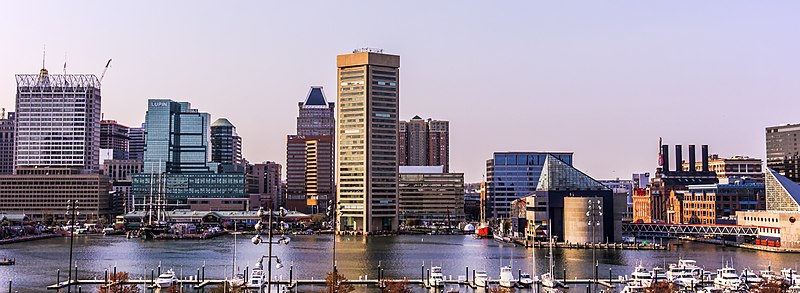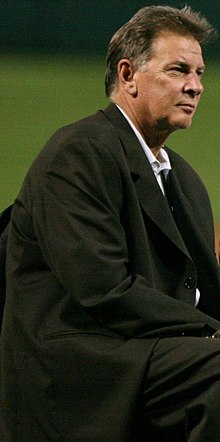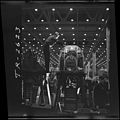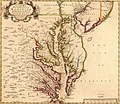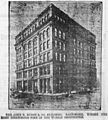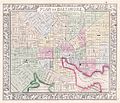Portal:Baltimore
The Baltimore Portal

Baltimore is the most populous city in the U.S. state of Maryland. With a population of 585,708 at the 2020 census, it is the 30th-most populous US city. Baltimore was designated as an independent city by the Constitution of Maryland in 1851. It is the most populous independent city in the nation. As of 2020[update], the population of the Baltimore metropolitan area was 2,838,327, the 20th-largest metropolitan area in the country. The city is also part of the Washington–Baltimore combined statistical area (CSA), which had a 2020 population of 9,973,383, the third-largest in the country. Though Baltimore is not located within or under the administrative jurisdiction of any county in the state, it is part of the central Maryland region, together with the surrounding county that shares its name.
The land that is present-day Baltimore was used as hunting ground by Paleo-Indians. In the early 1600s, the Susquehannock began to hunt there. People from the Province of Maryland established the Port of Baltimore in 1706 to support the tobacco trade with Europe, and established the Town of Baltimore in 1729. During the American Revolutionary War, the Second Continental Congress, fleeing Philadelphia prior to its fall to British troops, moved their deliberations to Henry Fite House on West Baltimore Street from December 1776, to February 1777, permitting Baltimore to serve briefly as the nation's capital, before it returned to Philadelphia in March 1777. The Battle of Baltimore was pivotal during the War of 1812, culminating in the failed British bombardment of Fort McHenry, during which Francis Scott Key wrote a poem that would become "The Star-Spangled Banner", designated as the national anthem in 1931. During the Pratt Street Riot of 1861, the city was the site of some of the earliest violence associated with the American Civil War. (Full article...)
Selected article -
The music of Baltimore, the largest city in Maryland, can be documented as far back as 1784, and the city has become a regional center for Western classical music and jazz. Early Baltimore was home to popular opera and musical theatre, and an important part of the music of Maryland, while the city also hosted several major music publishing firms until well into the 19th century, when Baltimore also saw the rise of native musical instrument manufacturing, specifically pianos and woodwind instruments. African American music existed in Baltimore during the colonial era, and the city was home to vibrant black musical life by the 1860s. Baltimore's African American heritage to the start of the 20th century included ragtime and gospel music. By the end of that century, Baltimore jazz had become a well-recognized scene among jazz fans, and produced a number of local performers to gain national reputations. The city was a major stop on the African American East Coast touring circuit, and it remains a popular regional draw for live performances. Baltimore has produced a wide range of modern rock, punk and metal bands and several indie labels catering to a variety of audiences.
Music education throughout Maryland conforms to state education standards, implemented by the Baltimore City Public School System. Music is taught to all age groups, and the city is also home to several institutes of higher education in music. The Peabody Institute's Conservatory is the most renowned music education facility in the area, and has been one of the top nationally for decades. The city is also home to a number of other institutes of higher education that have music programs, the largest being nearby Towson University. The Peabody sponsors performances of many kinds, many of them classical or chamber music. Baltimore is home to the Baltimore Opera and the Baltimore Symphony Orchestra, among other similar performance groups. Major music venues in Baltimore include the nightclubs and other establishments that offer live entertainment clustered in Fells Point and Federal Hill. (Full article...)
Selected picture -

Baltimore Basilica, the first cathedral built in the U.S.
Categories
WikiProjects
Selected biography -
Michael Kendall Flanagan (December 16, 1951 – August 24, 2011) was an American professional baseball left-handed pitcher, front office executive, and color commentator. He spent 18 years as a player in Major League Baseball (MLB) with the Baltimore Orioles (1975–1987, 1991–1992) and the Toronto Blue Jays (1987–1990).
Flanagan was a starting pitcher for the Orioles from 1975 through 1987. He was named to the American League (AL) All-Star Team once in 1978. In 1979, the first of two years he would play on an AL pennant winner, his 23 victories led the circuit and earned him the AL's Cy Young Award. He was a member of the Orioles' World Series Championship team in 1983. During the 1987 season, he was traded to the Toronto Blue Jays, with whom he pitched through 1990. He returned to Baltimore to close out his playing career as a relief pitcher in 1991 and 1992. During this second tour, he combined with three other pitchers to throw a no-hitter against the Oakland Athletics on July 13, 1991. He was also the last Orioles pitcher to appear in a major-league contest at Memorial Stadium. In an 18-season career, Flanagan posted a 167–143 record with 1,491 strikeouts and a 3.90 earned run average in 2,770 innings pitched. (Full article...)
Did you know...
- ... that one Baltimore Orioles player compared the 2024 Major League Baseball jerseys to knockoffs from TJ Maxx?
- ... that one of the items on display at the Baltimore Museum and Gallery of Fine Arts was George Washington's shaving brush?
- ... that Darryl De Sousa created a Baltimore Police Department unit to give lie detector tests to other units?
- ... that Charles J. M. Gwinn was the first state's attorney of Baltimore elected under the Maryland Constitution of 1851, which he had helped to draft?
General images -
News
No recent news
Related portals
Topics
Associated Wikimedia
The following Wikimedia Foundation sister projects provide more on this subject:
-
Commons
Free media repository -
Wikibooks
Free textbooks and manuals -
Wikidata
Free knowledge base -
Wikinews
Free-content news -
Wikiquote
Collection of quotations -
Wikisource
Free-content library -
Wikiversity
Free learning tools -
Wikivoyage
Free travel guide -
Wiktionary
Dictionary and thesaurus

